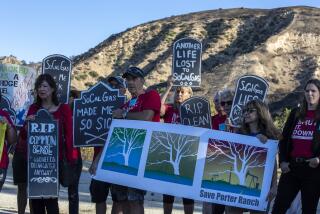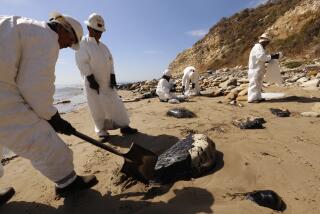State Proposes Using Tankers to Move Oil : Environment: Santa Barbara County officials and activists say the interim plan to ship crude along the Ventura coast during construction of a pipeline is risky.
- Share via
A state agency on Tuesday proposed that oil companies use tankers to carry millions of barrels of crude from Point Arguello offshore platforms, down the Ventura County coastline to refineries in Los Angeles for three years while a pipeline is being built.
But Santa Barbara County officials and area environmentalists--who have opposed repeated requests by Chevron Corp. and its partners for permission to ship oil on tankers along the coast--criticized the proposal as premature, misleading and without necessary environmental safeguards.
The Resources Agency of California offered the plan, backed by Gov. Pete Wilson, as a solution to the decade-long dispute over transporting oil from the Point Arguello oil platforms to Los Angeles-area refineries. If approved by state and local agencies, it would allow the oil companies to send tankers down the coast for three years during the pipeline’s construction.
But the proposal would not require Chevron to commit to building a pipeline until 15 months after tanker shipments had begun, said Linda Krop, an attorney with the Santa Barbara-based Environmental Defense Center.
In addition, she said, the agency’s announcement incorrectly implied that all the parties to the dispute had agreed in principle to the proposed settlement.
“It’s a sellout, and it does not provide any incentive for them to build a pipeline,” she said. “This is the result of tremendous pressure brought on the state and local governments by the oil industry.”
Andrew H. McLeod, assistant secretary of the resources agency, acknowledged that the parties did not agree with some aspects of the plan. But he said it represented “the conclusion of the facilitating process” among the parties.
At issue is whether to allow Chevron and its 17 partners in the $2.5-billion Point Arguello project to send heavy crude oil by tanker from Gaviota to Wilmington in Los Angeles County until a new pipeline is built. Oil industry experts and environmentalists agree that pipelines are safer than tankers in transporting oil. The dispute has immobilized the massive project for years. In the past year, Chevron has begun producing about 30,000 to 35,000 barrels a day, sending 20,000 barrels by pipeline to Northern California and 15,000 barrels by pipeline east through Kern County and then south to Los Angeles County refineries.
Santa Barbara County Supervisor Tom Rogers said Tuesday that the county will not oppose using tankers as an interim measure if at least two conditions are met. The county wants Chevron to ship as much oil as possible through existing pipelines before it ships any by tanker. And county officials want Chevron to commit to the new pipeline before it begins shipping oil by tanker.
“We don’t feel this proposal is the framework for a resolution yet,” Rogers said.
Richard Harris, assistant general counsel for Chevron, said the oil company agrees with the proposal overall and intends to pursue it.
But Chevron also has points of disagreement. For instance, the company does not want to use the existing pipelines. The oil now sent through Kern County has to be mixed with thinner oil for shipping, resulting in a product that is difficult to sell, Harris said.
Chevron also opposes the plan’s “milestones,” which set, among other things, the 15-month time frame by which Chevron must commit to building a new pipeline or discontinue using tankers.
“We disagree that the milestones are necessary,” Harris said. “No number of milestones or regulatory incentives will create or make a new pipeline possible if the market doesn’t support it.”
The resources agency’s proposal came after three months of negotiations involving the oil company, the county, environmentalists and the California Coastal Commission, with the resources agency staff acting as facilitators.
Santa Barbara County, fearing an increased risk of oil spills and greater air pollution from tankers, denied Chevron’s proposal last year to tanker oil until a pipeline could be built. Chevron appealed the decision to the Coastal Commission, which upheld the county’s position. Chevron subsequently sued the commission and the county.
Under a provision of the state proposal, the Coastal Commission could reclaim jurisdiction from the courts and make the final decision on whether to allow any tanker shipments. Santa Barbara County officials, however, prefer that Chevron bring its request back to the Board of Supervisors, Rogers said.
The county has scheduled a public hearing on the issue Monday. The Coastal Commission will discuss the matter in a closed session April 8.
If the proposal is approved, it would allow no more than six tanker trips a month along the coast, the resources agency said.
The pipeline, if built as proposed by the Pacific Pipeline Co., would snake from Gaviota through Santa Barbara County and then into Ventura County along the Southern Pacific railroad’s right of way next to the Santa Clara River. It would pass through Santa Clarita and then head south through Burbank and Los Angeles.
The line would end in two prongs in the South Bay, one running to the Chevron refinery in El Segundo and the other to the Texaco refinery and the GATX Corp. terminal in Wilmington.
More to Read
Sign up for Essential California
The most important California stories and recommendations in your inbox every morning.
You may occasionally receive promotional content from the Los Angeles Times.










